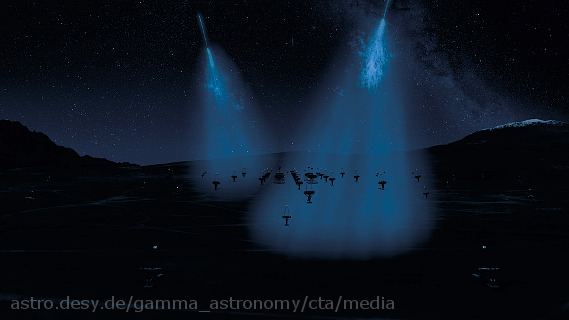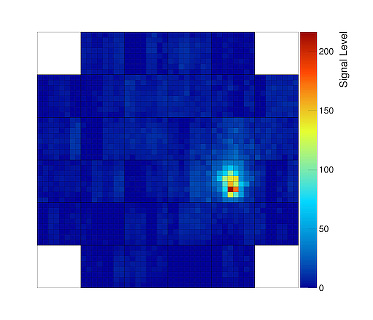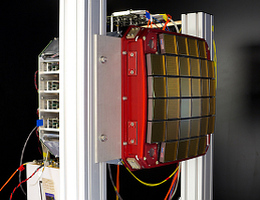Air showers
The following image is a representation of the type of air shower described in the box at left.
The result of the shower is a large, conical burst of light that bathes the area of ground covered by the telescope array (either wholly, or only partially). This light is collected by a telescope mirror, and focused on the camera.
By analysing the shape of the image thus produced by each telescope, the direction of arrival of the shower can be determined- and thus also the location in the sky of the astronomical object that produced the originating gamma-rays, since gamma-rays travel in a straight line from the source.
What the camera sees...
The image below shows the type of image recorded by one of the camera prototypes during field testing.
The image was obtained during testing in France. Hotter colours (yellows and reds) indicate more light recorded by a given pixel. In this camera design, there are 2,048 pixels.
What is the Cherenkov technique?
When a charged particle travels through some medium at a speed greater than the speed of light within that medium, electromagnetic radiation is emitted by that particle, in the direction of its motion.
In our case, when a gamma-ray photon from an astronomical source enters the Earth's atmosphere, the interaction between that photon and molecules and atoms in our atmosphere causes an electron-positron pair to created. These charged particles move faster than the speed of light in air, and thus emit photons in the near ultra-violet part of the optical spectrum.
These bursts of light are of extremely short duration, and, compared with the background of the night sky with which we are familiar, are very faint.
However, using specialist optical detectors of the type that make up the CTA array, we are able to detect these flashes. Whilst we do not see the gamma-rays themselves directly, we see the result of their interaction with our atmosphere, and we can deduce the energy and the direction from which the gamma-rays came by analysing the Cherenkov flashes.
The Telescopes
No matter what its size or exact design, each CTA telescope consists of three main sections.
The camera : mounted at the focus of the mirror, this consists of a large number of very sensitive light-detecting elements (solid-state photo-multipliers in this case) which also have very high time resolution. They detect the extremely brief Cherenkov flashes, and the camera electronics then convert the signal into a digital format suitable for analysis.
The mirror : a light-reflecting surface that actually consists of a number of smaller mirror elements (a "segmented mirror") that are mounted so as to form a large curved surface, that focuses the light from the Cerenkov flashes (as well as starlight and the background sky) onto the camera.
The mount : this is the mechanical device that holds the various assemblies together, pointing them at the required location in the sky, as well as keeping the telescope tracking that location as observations are made.
The images below show prototypes for the Compact High-Energy Camera (CHEC), and the Gamma-Ray Cherenkov Telescope (GCT) design for the Small-Sized Telescope (SST). (Credit: GCT and CHEC teams)
| A prototype camera | Segmented mirror | Mount (in red) |






